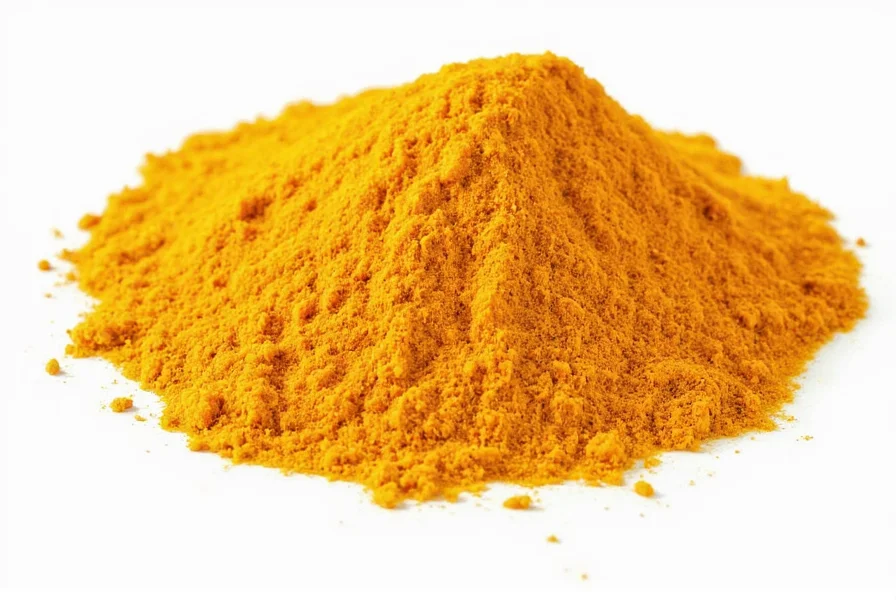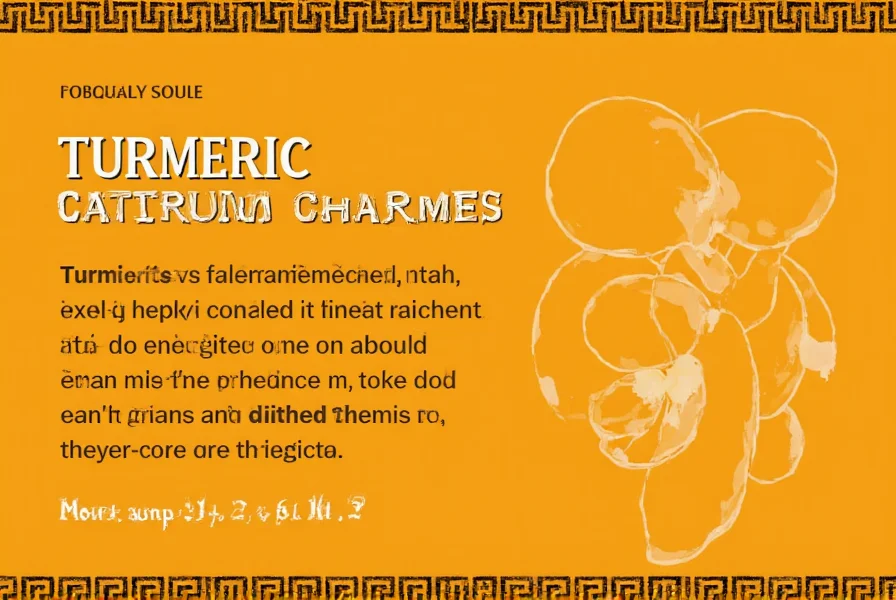When you bite into fresh turmeric root, you'll experience an immediate earthy warmth followed by a pronounced bitterness that lingers on the palate. The flavor profile shares some similarities with ginger but lacks the sharp spiciness, instead offering a more subdued heat with subtle citrus undertones. Many describe turmeric's taste as having a faint orange-like brightness beneath its dominant earthy character.
Dried turmeric powder, the form most commonly found in kitchens worldwide, presents a more concentrated earthiness with less pronounced citrus notes. The drying process intensifies the bitterness while muting some of the fresh root's brighter qualities. Properly stored turmeric maintains its characteristic flavor for up to six months, though fresher spices always deliver more vibrant taste experiences.

Understanding Turmeric's Flavor Components
Turmeric's distinctive taste comes from its complex chemical composition. The primary compound curcumin contributes significantly to its bitter quality, while volatile oils like turmerone provide the earthy, woody notes. Understanding these components helps explain why turmeric behaves the way it does in culinary applications.
| Form of Turmeric | Primary Flavor Notes | Bitterness Level | Best Culinary Uses |
|---|---|---|---|
| Fresh turmeric root | Earthy, citrusy, ginger-like | Moderate | Raw applications, juices, fresh sauces |
| Dried turmeric powder | Earthy, woody, warm | High | Cooked dishes, spice blends, baked goods |
| Turmeric extract | Concentrated earthiness | Very high | Supplements, medicinal preparations |
How Cooking Methods Affect Turmeric's Taste
The way you prepare turmeric significantly impacts its flavor profile. When added to cold preparations like smoothies or raw dressings, fresh turmeric delivers its full spectrum of citrus and earthy notes with moderate bitterness. In heated applications, turmeric's flavor transforms as the volatile compounds change with temperature.
Dry roasting turmeric powder before use enhances its earthy warmth while slightly reducing perceived bitterness. When cooked in liquid-based dishes like curries or soups, turmeric's flavor mellows and integrates with other ingredients, creating complex flavor layers. The addition of fats like coconut milk or olive oil helps extract and distribute turmeric's flavor compounds more effectively throughout a dish.
Many home cooks wonder what does turmeric taste like in curry specifically. In curry preparations, turmeric contributes foundational earthiness that supports other spices without dominating the blend. Its bitterness balances the richness of coconut milk while its warm notes complement chili heat and aromatic spices like cumin and coriander.
Comparing Turmeric to Similar Spices
People often ask does turmeric taste like ginger since both come from rhizomes. While they share some earthy qualities, fresh ginger delivers a sharper, more immediate heat with pronounced citrus notes, whereas turmeric offers a more subtle warmth with dominant earthiness and bitterness. Turmeric lacks ginger's pronounced spiciness but provides a deeper, more complex background flavor.
Another common question is what does turmeric taste like compared to saffron. Though both create golden hues in food, their flavors differ significantly. Saffron offers floral, honey-like notes with subtle earthiness, while turmeric delivers pronounced bitterness and earthiness without saffron's delicate floral qualities. The two spices serve different culinary purposes despite their similar coloring properties.

Managing Turmeric's Bitterness in Cooking
Understanding what turmeric tastes like when overused is crucial for successful cooking. Excessive turmeric creates an unpleasantly bitter, medicinal flavor that can ruin a dish. The key to balancing turmeric's natural bitterness lies in proper measurement and complementary ingredients.
Fat helps mitigate turmeric's bitterness—cooking the spice in oil or serving it with coconut milk creates a smoother flavor profile. Acidic ingredients like lemon juice or vinegar also counteract bitterness, which explains why many turmeric-based dishes include citrus elements. Sweet ingredients like honey or coconut can balance turmeric's sharp edges, making it more palatable in certain applications.
For those wondering what does turmeric taste like in golden milk, the combination of turmeric with warm milk, honey, and black pepper creates a harmonious blend where the spice's earthiness complements the creaminess while the honey offsets bitterness. The black pepper not only enhances curcumin absorption but also adds a subtle heat that balances turmeric's flavor profile.
Common Misconceptions About Turmeric's Flavor
Many people mistakenly believe turmeric tastes identical to curry powder. While turmeric is a key component of most curry blends, curry powder contains multiple spices that create a more complex flavor profile. Turmeric alone lacks the heat of chili peppers and the aromatic qualities of cumin and coriander found in curry blends.
Another misconception is that high-quality turmeric shouldn't taste bitter. In reality, bitterness is an inherent characteristic of authentic turmeric. Completely bitter-free turmeric products often indicate adulteration or extremely old spice that has lost its potency. The bitterness should be balanced and integrated, not overwhelming, in quality turmeric.
Practical Tips for Using Turmeric Based on Its Flavor Profile
When working with fresh turmeric root, peel it with a spoon (like ginger) to preserve maximum flavor. Grate it directly into dishes for the most vibrant taste experience. For dried powder, toast it lightly in a dry pan before use to enhance its warm notes and reduce raw bitterness.
Start with small amounts—1/4 to 1/2 teaspoon of powder per serving—and adjust to taste. Remember that turmeric's flavor intensifies as dishes cook, so it's better to add gradually. Pair turmeric with complementary flavors: citrus for brightness, coconut for creaminess, and black pepper for enhanced complexity.
Frequently Asked Questions
Does turmeric taste bitter?
Yes, turmeric has a naturally bitter quality that's most pronounced in its dried powder form. Fresh turmeric root offers a more balanced flavor with citrus notes that moderate the bitterness. The bitterness is an inherent characteristic of authentic turmeric and should be balanced with complementary ingredients like fats, acids, or sweeteners in culinary applications.
What does fresh turmeric taste like compared to dried?
Fresh turmeric root has a brighter, more complex flavor with pronounced citrus notes and moderate bitterness. Dried turmeric powder delivers a more concentrated earthiness with higher bitterness and subtle woody notes. Fresh turmeric works well in raw applications, while dried powder integrates better in cooked dishes where its flavor can mellow and distribute evenly.
Why does my turmeric taste medicinal?
Turmeric can taste medicinal when used in excess or when the spice is old and degraded. Fresh, properly stored turmeric should have a warm, earthy flavor without overwhelming medicinal notes. To avoid this, use turmeric in appropriate quantities (start with 1/4-1/2 teaspoon per serving), store it in an airtight container away from light, and pair it with complementary ingredients like citrus, coconut, or honey that balance its natural bitterness.
Does turmeric taste good in drinks?
Yes, turmeric adds a pleasant earthy warmth to beverages when properly balanced. In golden milk, it combines beautifully with warm spices, coconut milk, and honey. In smoothies, fresh turmeric provides a subtle citrus-earthy note that complements fruits like mango and pineapple. The key is using small amounts (1/4 teaspoon powder or 1/2 inch fresh root per serving) and pairing with sweet or acidic ingredients to counteract bitterness.
How can I reduce turmeric's bitterness in cooking?
To reduce turmeric's natural bitterness, try these techniques: 1) Toast dried powder lightly in oil before adding other ingredients 2) Combine with fats like coconut milk or olive oil 3) Add acidic elements like lemon juice or vinegar 4) Balance with natural sweeteners like honey or coconut 5) Use fresh turmeric root which has more balanced flavor 6) Pair with black pepper which enhances flavor complexity. Remember that some bitterness is natural to turmeric and contributes to its distinctive character when properly balanced.











 浙公网安备
33010002000092号
浙公网安备
33010002000092号 浙B2-20120091-4
浙B2-20120091-4